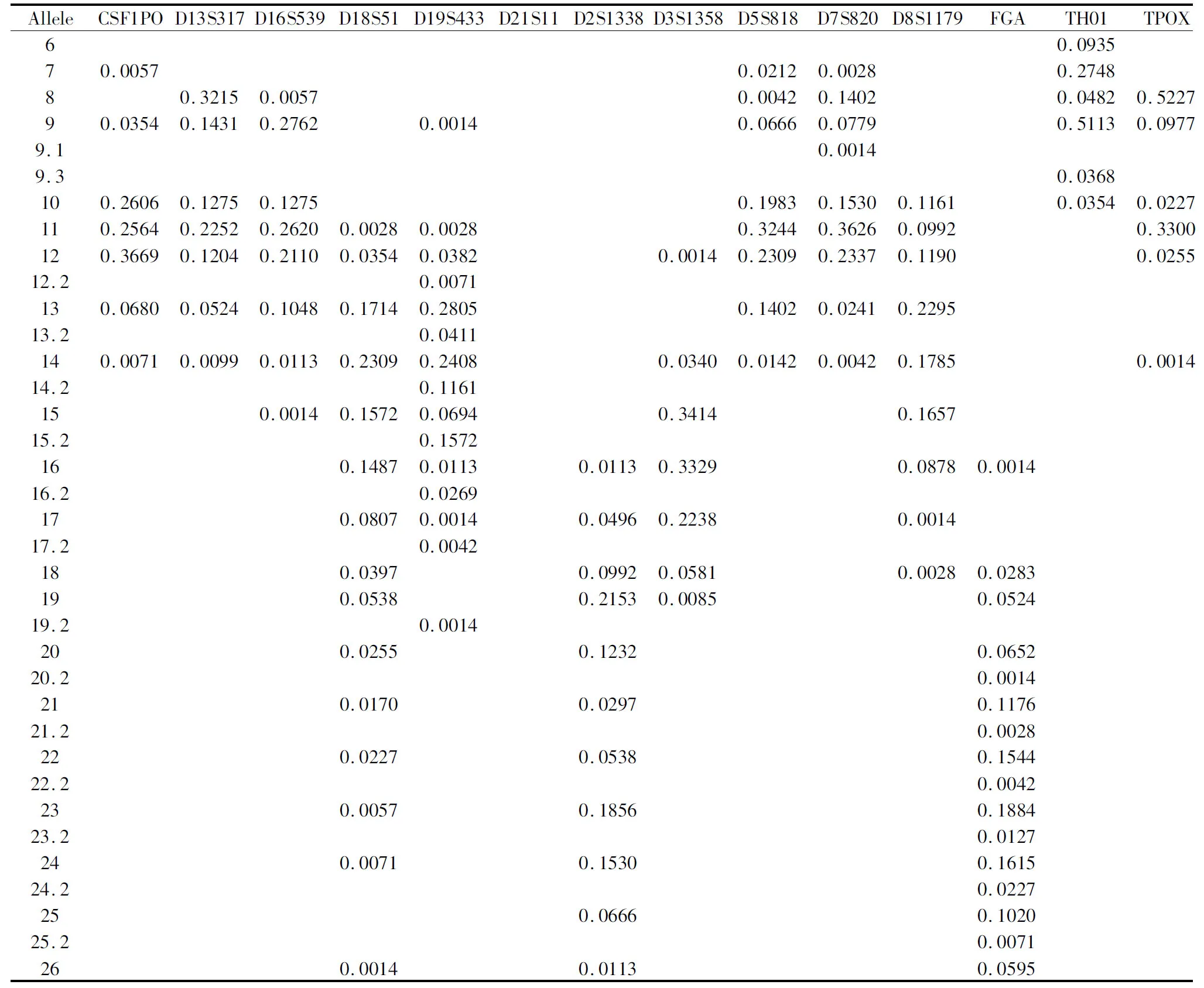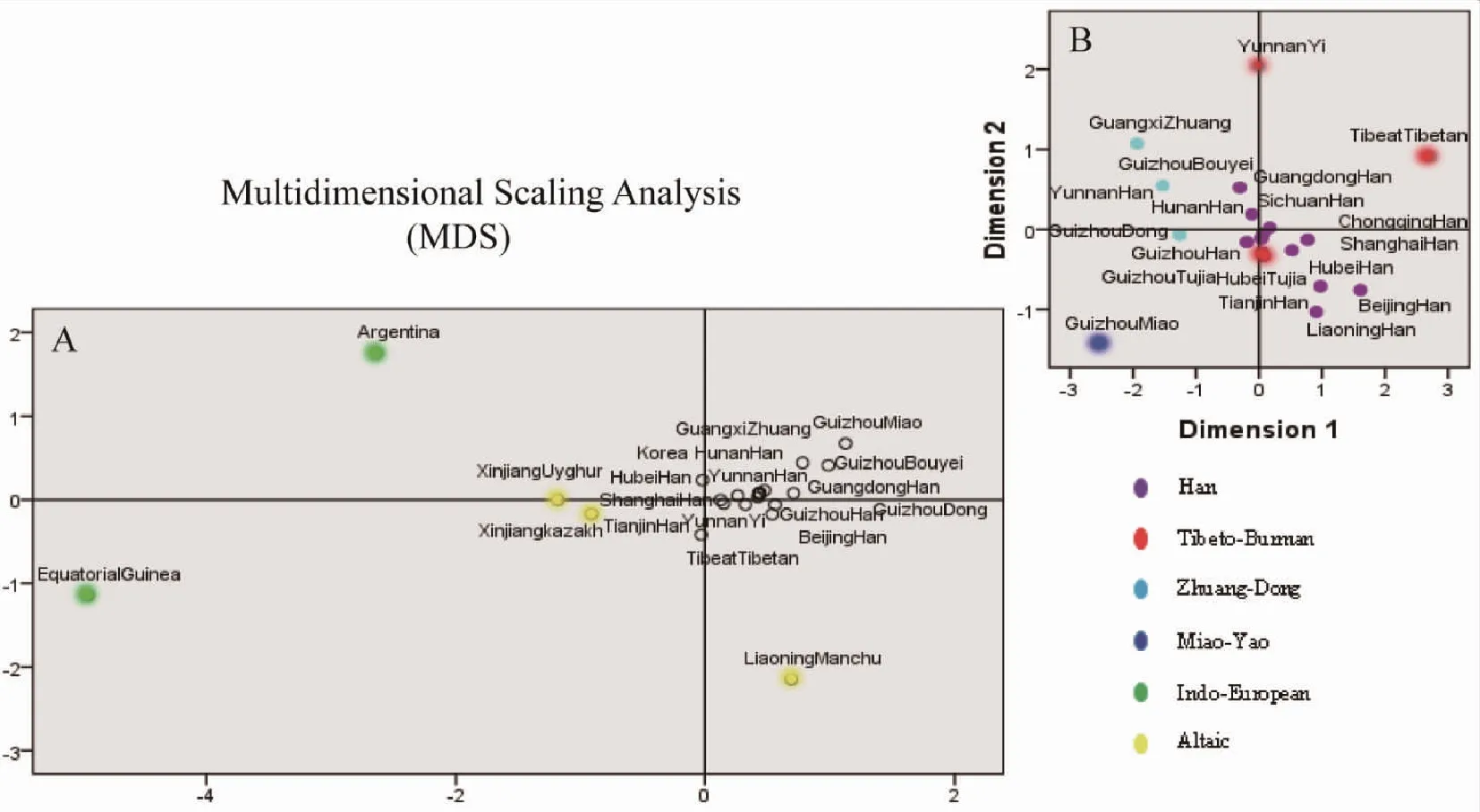Phylogenetic characteristics and population genetic diversity of 15 autosomal STR loci in Tujia population of Guizhou of China
, , , , n, ,
(1.Center of Forensic Expertise,Affiliated Hospital of Zunyi Medical University,Zunyi Guizhou 563099,China; 2.Criminal Technology Department,Zunyi Public Security Bureau,Zunyi Guizhou 563003,China)
[Abstract]Objective To investigate the genetic polymorphisms of 15 STR loci in the Tujia ethnic minority of Guizhou province,and explore the genetic relationship with other populations at home and abroad.Methods Fifteen STR loci (CSF1PO,D3S1358,D5S818,D7S820,D8S1179,D13S317,D16S539,D18S51,D21S11,FGA,TH01,TPOX,vWA,D2S1338 and D19S433) were amplified in 353 unrelated healthy Tujia population residing in northern Guizhou.Modified-Powerstates and Arlequin were used to calculate the allele frequencies and forensic parameters.Phylip,Mega and SPSS software were applied to structure population genetic relation.Results No evidence of deviation from the Hardy-Weinberg equilibrium (HWE) was identified.A total of 392 alleles was founded and the allelic frequencies spanned from 0.0014 (D7S820) to 0.5227 (TPOX).The cumulative power of discrimination (CDP) and the cumulative probability of exclusion(CPE) of 15 STR loci were 0.99999999999999999541338655 and 0.999998251,respectively.Genetic distance,N-J tree and MDS revealed that the farthest genetic distance was between Guizhou Tujia and Argentina population,whereas the nearest was among Guizhou Tujia and Hubei Tujia.Conclusion These 15 STR loci have high polymorphisms,which could be utilized as a powerful tool for forensic paternity test and personal identification in Guizhou Tujia population.The population comparison demonstrates that Guizhou Tujia had a close genetic relationship with adjacent geographic Hubei Tujia and Han populations,whereas Guizhou Tujia was obviously different from Argentina population.
[Key words]forensic science; short tandem repeat; genetic polymorphisms; Guizhou Tujia population
Short tandem repeat is a kind of variable number of tandem repeat (VNTR),which was first described as a valid tool in forensic science and medicine in the early 1990s[1].STR is also a short DNA fragment with a simple repeat of 3~7 base pairs in length.Nowadays,STR has become an indispensable application value in forensic science on account of high polymorphism,multiplex amplification and labouring saving[2].Guizhou province is located in the southwestern hinterland of China,bording Chongqing,Sichuan,Yunnan,Guangxi and Hunan province.Guizhou is also a multi-ethnic province,where the majority is Han population(62%),and the followings are Miao(12%),Bouyei(8%),Dong(5%),Tujia(4%) and any other ethnic groups(7%) (https://en.wikipedia.org/wiki/Guizhou) .Tujia is the 8th largest ethnic minority in China,reside in the Wuling Mountains,straddling the common borders of Hunan,Hubei,Guizhou and Chongqing province.populations genetic data of most populations in Guizhou Province have been reported,while that of Tujia ethnic minority is lack.In our study,we investigated 353 Tujia residents from Yinjiang and Yanhe,the most populous areas of Tujia in Guizhou,so as to establish the autosomal STR database of Guizhou Tujia population for forensic application in personal identification and parentage testing,and relationship exploring between Guizhou Tujia and other 24 populations[3-25].
1 Materials and methods
1.1 Materials Under the international ethical guidelines,we randomly obtained the blood from 353 Tujia healthy individuals residing in northern Guizhou whose three generations were unrelated,all the samples were restored by EDTA anticoagulant tube under -20℃ until use.All the individuals signed informed consent.
1.2 PCR amplification and genotyping Genomic DNA was extracted from Chelex-100 described by Walsh et al[26].15 STR loci and an Amelogenin locus were amplified by using the AmpFlSTR Identifiler Plus PCR Amplification Kit (Applied Biosystems,Foster City,CA,USA) following the manufacturer's advice in a 10μl volume system,including Master Mix 4μl,DNA polymerase 0.2μl,a mixture of upstream and downstream primers 2μl,ddH2O 2.8μl and the template DNA samples for 1μl.PCR was performed by GeneAmp PCR System 9700 Thermal Cycler (Applied Biosystems,Foster City,CA,USA).PCR cycling was employed as 95 °C for 3 min,followed by 30 cycles of 94 °C for 30 s,60 °C for 1 min,72 °C for 1 min,and a fnal extension at 60 °C for 12 min and 4 °C for preservation.PCR products were detached through capillary gel electrophoresis by ABI3130 genetic analyzer (Applied Biosystems,Foster City,CA,USA).Under the electrophoresis,allelic genotypes were identified using GeneScan Analysis V3.7[27](Applied Biosystems,Foster City,CA,USA) and Genetyper V3.7 software[27](Applied Biosystems,Foster City,CA,USA).A positive control and negative control standards were went through all the experiments.
1.3 Statistical analysis The allele frequencies,matching probability (MP),power of discrimination (PD),polymorphism information content (PIC),power of exclusion (PE),paternity Index (PI) were calculated using Modified-Powerstates.The probability of Hardy Weinberg equilibrium (HWE),linkage disequilibrium (LD),heterozygosity (Ho) were computed by Arlequin V3.1[28].The Nei’s genetic distances were calculated by Phylip V3.695 software (http:// evolution.genetics.washington.edu/ phylip.html.) and visualized as the neighboring joining tree(N-J tree) in Mega V7.0 software[29].Moreover,multidimensional scaling (MDS) of Guizhou Tujia and other reference populations were plotted using SPSS V17.0 software[30].
1.4 Reference populations To explore the pollution genetic structure between the Guizhou Tujia and neighbouring populations,a total of 24 populations mainly living in Guizhou and neighbouring Provinces including 11 Hans and 10 minorities,as well as 3 foreign populations were selected for comparison.These 24 comparison groups belong to 3 different languages families:①Sino-Tibetan language family(Guangxi Zhuang,Guizhou Bouyei,Guizhou Dong,Guizhou Miao,Guangdong Han,Yunnan Han,Yunnan Yi,Guizhou Han,Hubei Tujia,Guizhou Tujia,Sichuan Han,Chongqing Han,Hunan Han,Hubei Han,Shanghai Han,Liaoning Han,Tianjin Han,Beijing Han,Tibetan); ②Altaic language family(Korean,Liaoning Manchu,Xinjiang Kazakh,Xinjiang Uyghur); ③Indo-European family(Argentina and Equatorial Guinea).
2 Results
2.1 The allelic frequency and corresponding forensic parameters were performed in Table 1.A total of 392 alleles were founded in the 15 loci,and the allelic frequencies spanned from 0.0014 to 0.5227.All of the 15 loci were in agreement with the HWE and LD after Bonferroni correction.The highest MP was observed at TPOX (0.2205) and the lowest was at FGA (0.0283).The lowest PD was detected at TPOX (0.7795),while the highest was at FGA (0.9717).The PIC results came to the same thing,all of the 15 loci reached above 0.6 other than TPOX (0.5395).The maximum He was observed at D2S1338 (0.8924) and the minimum at TPOX (0.6232),PE discovered the same results.The CDP and the CPE of 15 STR loci were 0.99999999999999999541338655 and 0.999998251,respectively.
Tab1Thedistributionofallelefrequencies,forensicefficiencyandstatisticalparameterson15STRlociinGuizhouTujiapopulation(n=353).

Tab1(continued)

MP:matching probability; PD:Power of Discrimination; PIC:Polymorphism Information Content; PE:Power of Exclusion; PI:Paternity Index; Ho:observed Heterozygosity;p-HWE:probability for Hardy Weinberg equilibrium (HWE).
2.2 We used the neighbour joining tree to explore genetic relationships between Guizhou Tujia and other populations (Table 2 and Figure 1).The neighbour joining tree was on the basis of the Nei’s distances,demonstrating that the remoter genetic distance was between Guizhou Tujia,Argentina population(0.1124) and Equatorial Guinea population (0.1939),whereas the nearest was among Guizhou Tujia,Guizhou Han (0.0023),Sichuan Han (0.0025),Hunan Han (0.0029),Hubei Han (0.0031),Yunnan Han (0.0033),Hubei Tujia (0.0033) and Chongqing Han (0.0035).The N-J tree was clustered in two groups:The Argentina and Equatorial Guinea grouped in one branch,and the other 23 comparisons clustered together in another branch.Guizhou Tujia gathered with Hubei Tujia first and then got together with the rest of populations.
Tab2TheNei'sgeneticdistancebetweentheGuizhouTujiaandother24referencepopulations

[1][2][3][4][5][6][7][8][9][10][11][12][13][14][15][16][17][18][19][20][21][22][23][24][25]Tianjin-Han[1]Shanghai-Han[2]0.0037Beijing-Han[3]0.00660.0068Hunan-Han[4]0.00430.00290.0069Hubei-Han[5]0.00250.00180.00600.0014Guangdong-Han[6]0.00980.00720.01330.00360.0055Yunnan-Han[7]0.00600.00450.00930.00190.00270.0043Chongqing-Han[8]0.00490.00400.00830.00150.00250.00450.0027Sichuan-Han[9]0.00410.00280.00660.00080.00140.00410.00160.0017Guizhou-Han[10]0.00550.00430.01000.00180.00240.00470.00180.00280.0012Liaoning-Han[11]0.00370.00530.00740.00580.00470.01200.00760.00630.00580.0072Guangxi-Zhuang[12]0.02350.01830.02810.01110.01610.00780.00990.01210.01130.01050.0245Guizhou-Bouyei[13]0.01870.01490.02090.00850.01200.00860.00720.00960.00800.00670.02070.0053Guizhou-Dong[14]0.01360.01190.01750.00600.00940.00640.00490.00640.00590.00470.01390.00650.0054Guizhou-Miao[15]0.02530.02510.03130.01710.02180.01790.01540.01760.01640.01270.02660.01760.01330.0086Yunnan-Yi[16]0.01750.01470.02110.01190.01300.01190.00770.01200.01120.01200.01790.01580.01530.01310.0275Hubei-Tujia[17]0.00700.00530.01010.00330.00400.00720.00420.00460.00340.00320.00730.01400.01050.00750.01860.0139Tibeat-Tibetan[18]0.01470.01240.01270.01590.01330.02050.01580.01660.01390.01700.01800.03580.02910.02910.04620.02240.0185Xinjiang-Uyghur[19]0.03370.02900.03540.03320.03060.03420.03330.03410.03360.03620.03550.04800.04980.04030.06190.03180.03590.0328Xinjiang-kazakh[20]0.02330.02140.02700.02430.02220.02640.02500.02570.02370.02620.02650.04120.04140.03190.05000.02700.02720.02490.0075Liaoning-Manchu[21]0.06430.06440.06730.06860.06590.07420.06960.06870.06870.07160.06470.09490.09250.08270.09570.07490.07500.07880.08540.0744Korea[22]0.00750.00680.01090.00780.00630.01390.00990.00980.00880.00930.00820.02750.02400.01680.02950.01850.00990.01700.02920.01910.0672Argentina[23]0.11480.10420.11730.11360.10970.11530.11520.11460.11520.11730.11240.12890.14100.12130.14770.11190.11250.10950.04570.05770.15930.0936ArEquatorial-Guinea[24]0.18480.18180.19360.18800.18370.19060.18960.18720.1880.19330.19060.20680.21840.19990.23620.17860.18680.17710.11640.12720.21170.18180.1551Guizhou-Tujia[25]0.00570.00450.01000.00290.00310.00560.00330.00350.00250.00230.00740.01300.00970.00590.01700.01310.00330.01800.03420.02610.07260.01020.11240.1939

Fig 1 phylogenetic tree on the basis of neighbor joining algorithm among 25 populations
2.3 In the MDS plot on the basis of all populations (Figure 2A),we also observed that the Chinese came together,while Argentina and Equatorial Guinea population were far away from Chinese.In the Sino-Tibetan languages MDS plot (Figure 2B),we discovered that Yunnan Yi and Tibet Tibetan were at the upper right corner; Guizhou Dong,Guizhou Bouyei and Guizhou Zhuang were at the upper left corner; Guizhou Miao was at the left bottom; the remaining populations were in the middle of plot.

Fig 2 Multidimensional Scaling analysis based on 15 overlapped STR loci of Guizhou Tujia and other 24 reference populations
3 Discussion
Our results showed all of the 15 loci were in agreement with the HWE,this means that the population sample collection meets the statistical requirements,the population is representative as well as the genotypes are reliable[24].All of the 15 loci were in accord with the linkage equilibrium after Bonferroni correction,this demonstrates that loci are independent of each other,and the product law can be used to calculate the forensic parameters[10].A total of 392 alleles were founded in the 15 loci,and the allelic frequencies spanned from 0.0014 to 0.5227.The DP and PE reflected the practical application value of genetic markers in forensic personal identification and paternity test,respectively.It is generally believed that the loci have a better value of forensic application when DP>0.7 and PE>0.5[14].The lowest PD was detected at TPOX (0.7795),while the highest was at FGA (0.9717).The PE results came to all of the 15 loci reached above 0.5 other than CSF1PO (0.4918),D3S1358 (0.4637),TH01 (0.3574) and TPOX (0.3197).According to the product law,the CDP and the CPE of 15 STR loci were 0.99999999999999999541338655 and 0.999998251,respectively.Therefore,these 15 STR loci have high polymorphism and have the potential to employ in paternity test and personal identification in Guizhou Tujia population.
A comprehensive population genetic structure among Guizhou Tujia and other 24 populations was revealed using N-J tree and MDS via 15 STR loci according to their ethic,linguistic family and geographic characteristics.Except Argentina and Equatorial Guinea populations,all others are homogenous groups as revealed in this study.Guizhou Tujia keeps the genetic affinity with ethnically different Han populations from geographically-neighboring positions,including Guizhou Han,Sichuan Han,Hunan Han,Hubei Han,Yunnan Han,Hubei Tujia and Chongqing Han.Whereas relatively distant to other Hans from other regions of China,such as Shanghai Han,Liaoning Han,Tianjin Han,Beijing Han etc.These results demonstrated that Guizhou Tujia have a more wide range of gene exchange with surrounding Han populations.Furthermore,remarkable hereditary differences among the compared Chinese minority groups were screened based on diverse methods and datasets.The closer genetic relationship was displayed between Guizhou Tujia and Hubei Tujia other than other ethnic minorities.From both the N-J tree and MDS plot,Guizhou Tujia clustered closely with the same ethnic population Hubei Tujia,while showed genetic difference with other ethnic minority groups from Southwest China (Guizhou Dong,Guizhou Miao,Guizhou Bouyei,Yunnan Yi and Guangxi Zhuang) as well as from other remote regions of China (Tibet Tibetan,Liaoning Manchu,Xinjiang Kazakh,Xinjiang Uyghur).Obvious geographical and linguistical cluster pattern can be discovered among these comparisons that Guizhou Tujia grouped with the same Tibeto-Burman language and adjacent Han populations,and far away from Liaoning Manchu,Xinjiang Kazakh,Xinjiang Uyghur,which belongs to Altaic language family and geographically distant.
In conclusion,our study revealed that these 15 STR loci are genetically polymorphic and discriminating in Guizhou Tujia population and could be used as a powerful tool in paternity test and personal identification.The population comparison demonstrated that Guizhou Tujia had a closer genetic relationship with adjacent geography such as Hubei Tujia who belong to the same ethnicity,as well as Han majority from adjacent regions such as Sichuan Han,whereas was obviously different from linguistically distinct populations from other countries such as Argentina.

